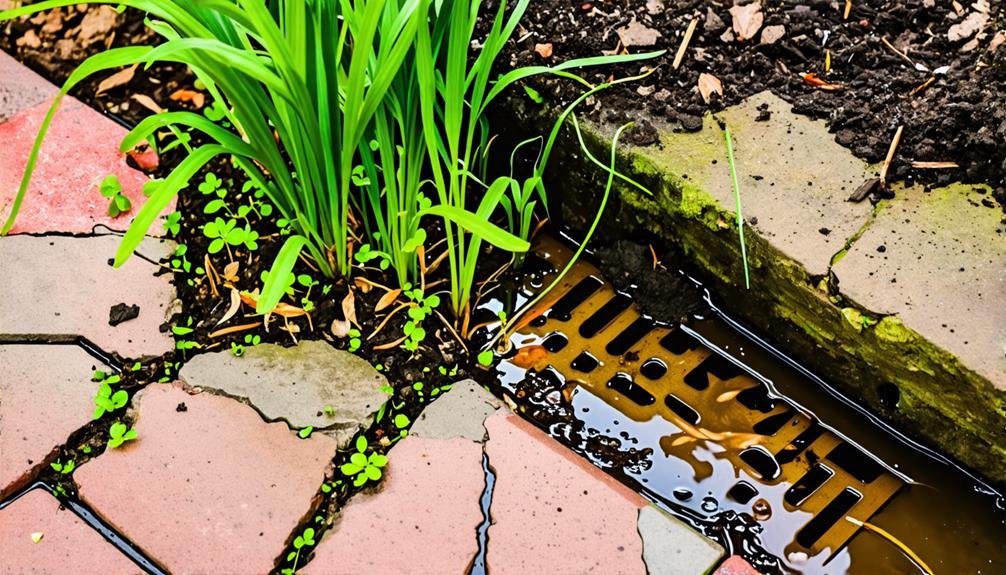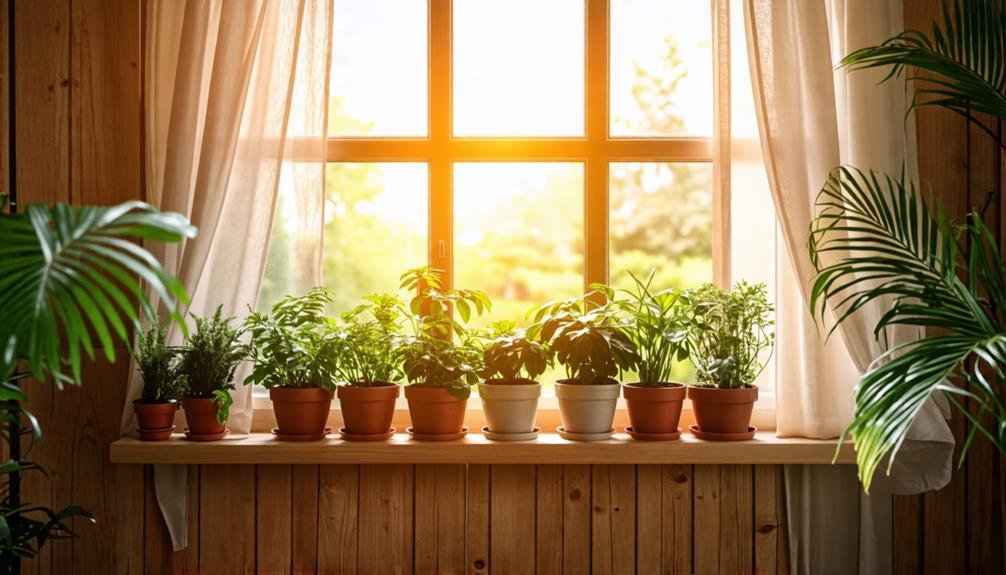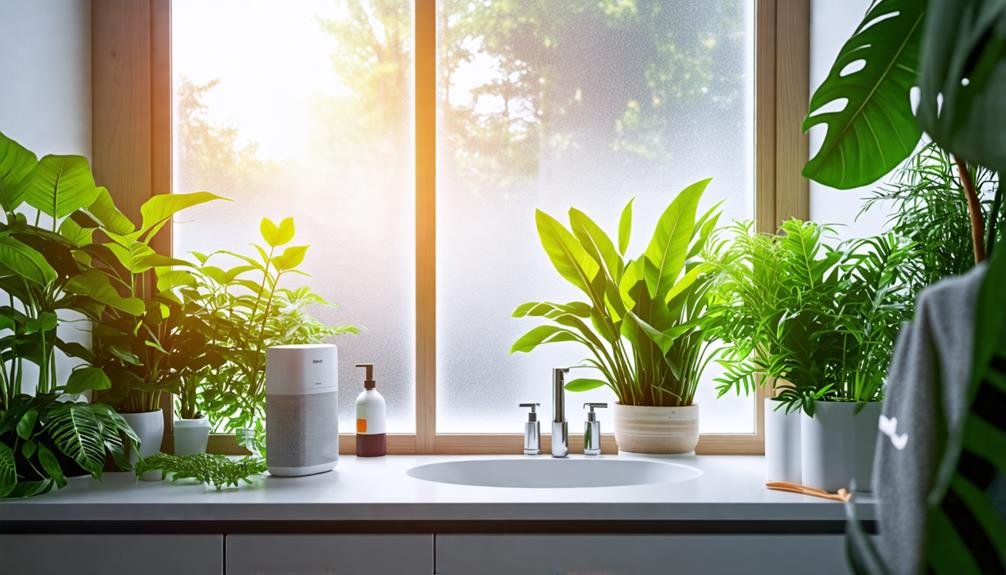Weeds on your patio can highlight important issues needing attention. Their growth, especially in cracks or through stones, often signals insufficient drainage, leading to water accumulation. This not only promotes additional weed proliferation but can create safety hazards, such as slippery surfaces or trip risks. Additionally, the root systems of these weeds may undermine soil integrity, complicating drainage problems. Regular inspections and prompt maintenance, like weed removal and applying landscape fabric, can preserve both functionality and aesthetics. Understanding these signs is crucial for patio longevity, and recognizing them will guide you towards effective solutions. More insights await your exploration.
Identifying Weeds in Patio Areas
Weeds frequently invade patio zones, appearing through fissures in the concrete or among uneven stones, indicating an urgent need for identification and elimination to preserve visual appeal and safety. These invasive plants can diminish the outdoor ambiance, making your patio look neglected and unwelcoming. Recognizing common weeds in patio settings, such as Taraxacum (dandelions), Trifolium (clover), and Digitaria (crabgrass), is essential, as they can undermine the structure of your patio.
Effective patio upkeep requires not only the extraction of visible weeds but also addressing foundational issues that foster their growth, such as poor water drainage. Regular evaluations can pinpoint locations where moisture accumulates, creating ideal conditions for weeds to flourish. By ensuring adequate drainage and swiftly eliminating any emerging weeds, homeowners can enhance the functionality and appearance of their outdoor areas.
Implementing materials like mulch, landscape fabric, or brands like Gardena weed barriers can hinder weed proliferation and elevate the overall patio aesthetics. Ultimately, timely weed management guarantees a safe, attractive, and enjoyable outdoor setting for relaxation and social gatherings.
Cracks and Surface Damage
Cracks and surface damage on a patio not only diminish its visual appeal but also create safety hazards and potential structural concerns that need prompt attention. These fissures can widen over time, resulting in trip hazards and lowering your property's overall value. A timely patio restoration is essential to preserve both functionality and aesthetics.
To mend minor fissures, begin by cleaning the affected area with a wire brush to eliminate debris. Then, apply a patching compound, ensuring that the surface is smoothed out for a seamless appearance. For larger fissures, it may be beneficial to consult professional services or consider repouring a new concrete slab for enduring results.
In addition to fissures, uneven pavers can pose similar risks. If pavers are lifting, address the underlying soil and sand to restore a level surface, or reset the pavers entirely. Regular assessments are recommended to identify these issues early, preventing further damage and maintaining a secure outdoor space. By prioritizing repairs and updates, you can enjoy a stunning, functional patio that enhances your outdoor lifestyle.
Drainage Problems to Watch

Effective water management is vital for preserving the structure of your outdoor flooring, as stagnant liquid can create hazardous surfaces and possibly cause foundational issues over time. Recognizing drainage challenges early on can prevent expensive restorations and enhance the functionality of your backyard. Here are four important indicators to monitor:
- Water Accumulation: Observe spots where liquid gathers post-rainfall; this points to inadequate grading or drainage systems.
- Surface Staining: Marks or darkened areas on the pavement can indicate moisture retention, which may lead to the degradation of materials like concrete or stone.
- Vegetation Proliferation: A rise in grass or weeds between tiles or fissures may hint at excessive moisture, revealing unfavorable drainage conditions.
- Soil Displacement: If you observe soil eroding from around your patio, this can threaten structural integrity and requires immediate intervention.
Tackling these drainage concerns swiftly not only enhances safety but also extends the lifespan of your patio. Routine upkeep and assessments will help maintain your outdoor area as a safe and attractive space, allowing you to enjoy it without worry for many years ahead.
Standing Water Concerns
Standing water on patios presents several dangers, including slippery surfaces and the attraction of pests, which can undermine both safety and enjoyment. When water gathers, it creates hazardous conditions, making outdoor areas less appealing and more risky. Additionally, persistent standing water can lead to the degradation of the patio material, potentially resulting in cracks that further endanger its structure.
To tackle the issue of standing water, it's essential to evaluate the drainage system of the patio. Checking for low-lying areas or spots where water accumulates is critical. Utilizing products like Quikrete self-leveling compound can provide a temporary fix for minor depressions, while more complex drainage issues may necessitate the expertise of a professional to ensure effective water flow.
Moreover, routine maintenance of the patio, including the removal of debris and ensuring that downspouts from brands like GutterStuff direct water away, can significantly reduce the likelihood of standing water. Taking these proactive measures not only enhances safety but also maintains the patio's visual charm. If standing water continues despite these efforts, considering a comprehensive renovation could be essential to keep your outdoor area both functional and enjoyable for years ahead.
Impact of Weeds on Drainage

Weeds often obstruct drainage systems on patios, exacerbating problems related to water buildup and potential harm to the surface. These invasive plants can penetrate cracks and joints, forming barriers that hinder the free flow of water. Managing the impact of weeds on drainage is crucial for preserving the structure of your outdoor space.
Here are four significant ways weeds influence drainage:
- Obstruction of Drainage Pathways: Weeds can thrive within and around drainage structures, impeding water movement and causing pooling.
- Soil Instability: The root systems of weeds can undermine the soil, leading to erosion and complicating drainage challenges.
- Enhanced Moisture Retention: Weeds can retain moisture, fostering a damp environment that encourages the growth of mold and mildew.
- Attraction of Insects: Stagnant water from inadequate drainage can attract insects, diminishing the enjoyment of your outdoor area.
Routine care, including weed removal and drainage inspections, can alleviate these issues and extend the lifespan of your patio. A proactive strategy ensures that your outdoor environment remains welcoming and functional, free from the obstacles that weeds create.
Signs of Structural Issues
Identifying signs of structural issues in your patio is important for maintaining its integrity and safety. Cracks in the concrete often indicate underlying problems that, if left untreated, can worsen over time and lead to further damage. Regular inspections are necessary to catch these issues early, allowing for timely repairs and preventing potential hazards.
Cracks Indicate Structural Problems
Identifying fractures in a concrete patio acts as a significant signal of potential structural issues that need prompt resolution. Overlooking these fractures can result in increased damage, creating safety risks and expensive repairs. Grasping the consequences of these visible markers is essential for upholding a secure and visually appealing outdoor area.
Here are four critical reasons why addressing fractures is essential:
- Safety Risks: Fractures can lead to uneven surfaces, heightening the likelihood of trips and falls.
- Water Damage: Fractures permit moisture to enter, which might cause further deterioration over time.
- Visual Impact: Unattractive fractures can diminish the overall charm of your patio, affecting real estate value.
- Expansion Risks: If neglected, fractures may broaden, leading to more substantial repairs or even necessitating a total patio overhaul.
Timely action can alleviate these dangers, ensuring your patio remains a safe and welcoming environment. For larger fractures, consider hiring a professional service or exploring options for pouring a new concrete slab, such as those offered by companies like Quikrete. Regular maintenance of these issues will contribute to your patio's durability and longevity.
Regular Inspections Essential
Regular inspections of your outdoor patio are crucial for identifying early signs of structural issues, which can prevent further damage and maintain a safe environment. Over time, elements such as rain, soil settlement, and tree roots can cause cracks in concrete or uneven pavers. These flaws not only diminish the visual appeal of your patio but also introduce significant safety hazards.
Make it a habit to examine the surface for any deterioration, like fissures or shifts in the stones. Pay attention to the buildup of debris or weeds in cracks, as these can exacerbate the issue. Taking care of minor cracks through proper cleaning and patching can prolong the life of your patio. However, extensive damage may necessitate professional help from specialists. Additionally, monitor drainage problems closely, as stagnant water can create slippery surfaces and lead to more serious structural concerns over time.
Trip Hazards From Weeds

Weeds can create significant trip hazards on patios, particularly when they grow between pavers or in cracks of concrete. Regular maintenance is crucial to prevent these hazards, including routine inspections and prompt removal of weeds. Implementing preventive measures, such as using landscape fabric or mulch, can help minimize weed growth and improve safety on your patio.
Weeds as Trip Hazards
Weeds can grow through cracks in concrete or between patio stones, creating significant trip hazards that threaten safety for users of outdoor spaces. Ignoring these plants may lead to accidents and injuries, detracting from the enjoyment of your patio. Recognizing this issue is vital, as weeds can point to deeper structural problems with your outdoor area.
Consider these aspects regarding weeds as trip hazards:
- Surface Disruption: Weeds can elevate the surface they invade, resulting in uneven areas that can easily trip someone.
- Obscured Visibility: Thick weed growth can obscure pathways, complicating safe navigation.
- Increased Risk for Children and Pets: The unpredictable nature of weeds poses particular dangers for kids and pets who may not notice obstacles.
- Potential for Falling: Trip hazards raise the likelihood of falls, which can lead to serious injuries, particularly among seniors.
Addressing weed growth quickly not only enhances the visual appeal of your patio but also ensures a safer environment for everyone.
Maintenance and Prevention Tips
Weeds pose a significant risk to patio safety, as they can create trip hazards and reduce usability. Regularly check your patio for weed growth, particularly in cracks or between stones. Removing weeds promptly not only enhances the visual appeal but also minimizes the dangers of uneven surfaces.
To combat weed growth, consider installing a high-quality landscaping fabric, such as those from GardenMat, beneath your paving stones. This can help maintain a flat surface while preventing weeds. Additionally, placing mulch or decorative gravel can serve as a natural barrier and improve the overall aesthetic of your outdoor space.
Routine upkeep, like using a pressure washer, can clear away dirt and organic matter that encourage weed growth. If weeds remain a problem, applying pre-emergent herbicides, such as those from Ortho, can stop future growth and lessen the need for manual removal.
Lastly, ensure your patio features proper drainage to avoid standing water, which fosters weed growth. By following these maintenance and prevention tips, you can create a safer, more enjoyable outdoor area that is free from the trip hazards associated with weeds.
Maintenance Tips for Patios
Regular upkeep enhances the durability and safety of your outdoor space. Consistent maintenance boosts the visual appeal while reducing potential risks, creating a secure area for gatherings. By promptly addressing small issues, you can prolong the lifespan of your patio and maintain its usability. Here are essential upkeep tips to consider:
- Frequent Sweeping: Clear your terrace regularly to eliminate debris, which prevents mold and mildew formation, reducing the risk of slippery surfaces.
- Crack Inspection: Examine the surface for cracks or uneven areas, as these can create trip hazards. Repair any damage promptly to ensure a safe environment.
- Weed Removal: Eliminate weeds that sprout between stones or in fissures, as they can undermine the structure and appearance of your patio.
- Sealant Application: Use a high-quality weather-resistant sealant, such as Thompson's WaterSeal, every few years to safeguard against moisture and weather-related damage, thus extending your patio's lifespan.
When to Call a Professional

Regular upkeep can reduce many issues, but certain circumstances require expert intervention to ensure safety and structural stability. If you observe large cracks in your concrete or uneven patio stones that create trip hazards, it is wise to contact a specialist. These cracks may worsen and lead to more serious problems if not addressed.
Pooled water is another critical concern. If your outdoor area frequently holds water, it can create slippery surfaces and damage the structure over time. Professionals can evaluate the drainage issues and propose solutions, which may involve regrading or installing new drainage systems.
Furthermore, if you intend to enlarge your patio area, professional advice will help ensure that the new slab blends well with the current layout. Correct leveling methods are crucial to prevent future hazards and drainage complications.






















You must be logged in to post a comment Login